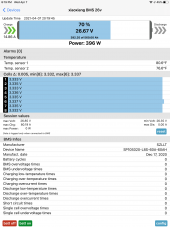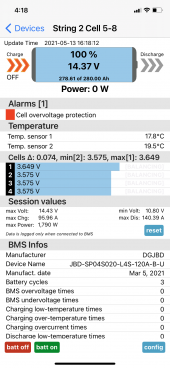I just got a Progressive Dynamics "PD9145ALV 12V Lithium Ion Battery Converter/Charger - 45 Amp" charger off Amazon. Amazon says "Electronic Current Limiting – Automatically reduces output voltage to prevent overheating and possible damage". But the manual that came with it says "When functioning as a regulated battery charger, the converter has a nominal voltage output of 14.6 VDC ... The system is designed to sense voltage on the battery and will taper charging current as the battery becomes charged."
This sound like it just sits at 14.6 volts all the time which doesn't "feel" right... The Victron solar charge controller I have has default settings of 14.2 Absorption (maybe a little low) but has Float voltage of 13.5V.
My question: Shouldn't the A/C powered charge controller also drop the voltage for 'float' when it is fully charged? If so, does anyone have recommendations of a more suitable 'shore power' LiFePO4 charger?
Thanks!
Kevin
ps- It is for an RV so I will be starting with only one or two 12V 100aH LiFePO4 batteries - either with 'shore power', or initially a 300W panel when boon docking. I just want to make sure they aren't over charging when on shore power.
This sound like it just sits at 14.6 volts all the time which doesn't "feel" right... The Victron solar charge controller I have has default settings of 14.2 Absorption (maybe a little low) but has Float voltage of 13.5V.
My question: Shouldn't the A/C powered charge controller also drop the voltage for 'float' when it is fully charged? If so, does anyone have recommendations of a more suitable 'shore power' LiFePO4 charger?
Thanks!
Kevin
ps- It is for an RV so I will be starting with only one or two 12V 100aH LiFePO4 batteries - either with 'shore power', or initially a 300W panel when boon docking. I just want to make sure they aren't over charging when on shore power.




